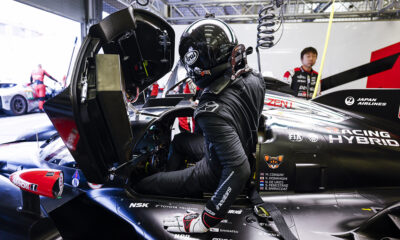
Photo: Porsche
Despite a new limitation in tire allocations, Michelin is aiming to maintain the same level of performance from last year with its newly developed LMP1 tires, according to Endurance Racing Program Manager Jerome Mondain.
A maximum of four sets of tires, instead of the previous six, are now enforced for LMP1 teams in six-hour FIA World Endurance Championship races, which will see both Porsche and Toyota required to double stint nearly every set in each regular season race.
“That’s the aim; that’s the main goal,” Mondain told Sportscaar365. “It’s to be able to bring the same level of performance and consistency as we were doing last year, generally over one stint, but now over two stints.
“It’s a big, big challenge that’s ambitious but that’s what we aim.
“We had encouraging results during the winter tests. Now we have to see how it will be in the field, with everyone on the track and in traffic, how the performance of the tire will be.”
The 33 percent reduction in overall tire usage in the WEC has seen significant off-season developments, which Mondain said started much earlier than normal in the French tire manufacturer’s schedule.
“Normally, we start development in September or October; this year, as we were obviously aware of the regulation changes, we started more during the summer, in July and August, to get the first feeling,” he said.
“Obviously it was going to take a bit more time to target to follow the evolution of the car. But we also needed more input and testing to adjust the tire to the new regulations.”
While testing at highly abrasive circuits such as Shanghai and Bahrain was not possible due to the costs involved, Michelin utilized reference points at venues such as Portimao to simulate the conditions LMP1 teams will be faced with later this year.
Mondain said the two end-of-year flyaway races, as well as the fifth round of the season at Circuit of The Americas, which returns to being a daytime race in September, will be the toughest on the tires.
“Those will be the biggest challenge, and also COTA this year, because that will be a daytime race,” he said. “Obviously the tarmac will be much hotter. We expect it much hotter.”
Toyota Gazoo Racing technical director Pascal Vasselon said he’s been pleased with the level of support Michelin has provided for the updated LMP1 hybrids, which has also underwent a reduction in downforce for this year.
“Michelin have been working very hard, not only for the downforce reduction but because of the rules changes in WEC,” Vasselon said.
“It’s a hard job. Michelin have been doing a lot of homework and we have major improvement from the tire side. We’re very happy with the work from Michelin.”
Porsche LMP1 team principal Andreas Seidl added: “On Michelin’s side, there was a big talk during the winter to further develop the construction of the tires and compounds in order to be ready for the challenge of double stinting tires for the [six-hour] WEC races.”
While the GTE-Pro class also sees limits reduced from six to four sets per race, Mondain said they’ve been supportive of the tighter restrictions in the championship.
“We were happy to follow because that’s the general philosophy of Michelin; also for the road tire to bring more [performance] for a longer period of time,” he said.
“Obviously that was a very interesting challenge and we are excited to follow the regulations and to see how it will be during the championship.”
The new-for-2017 rule, however, does not impact the 24 Hours of Le Mans, which remains at 12 sets for the top class in the race.
Mondain, though, indicated that Le Mans-specific tires, could be a thing of the past.
“We don’t aim to design one tire per race, even if the regulations allow that,” he said. “That’s not our philosophy. We prefer to have a sensible range with three or four different tires to cover the whole year, at all circuits.”























